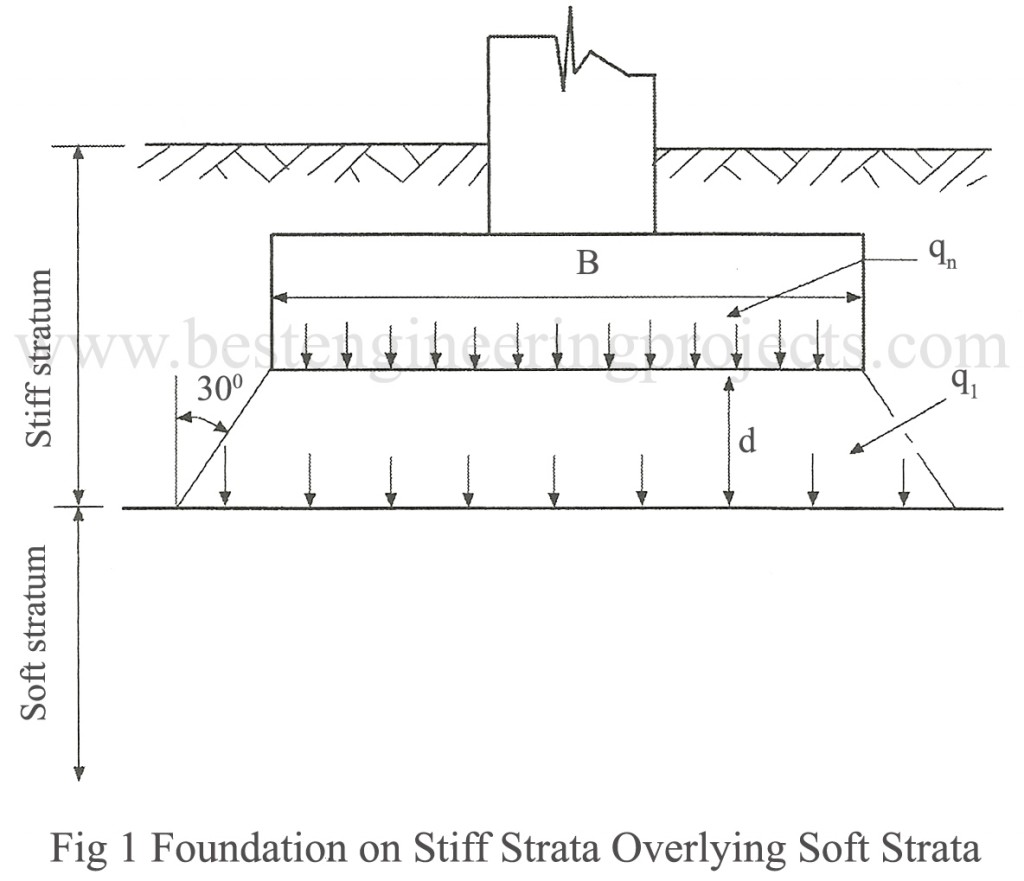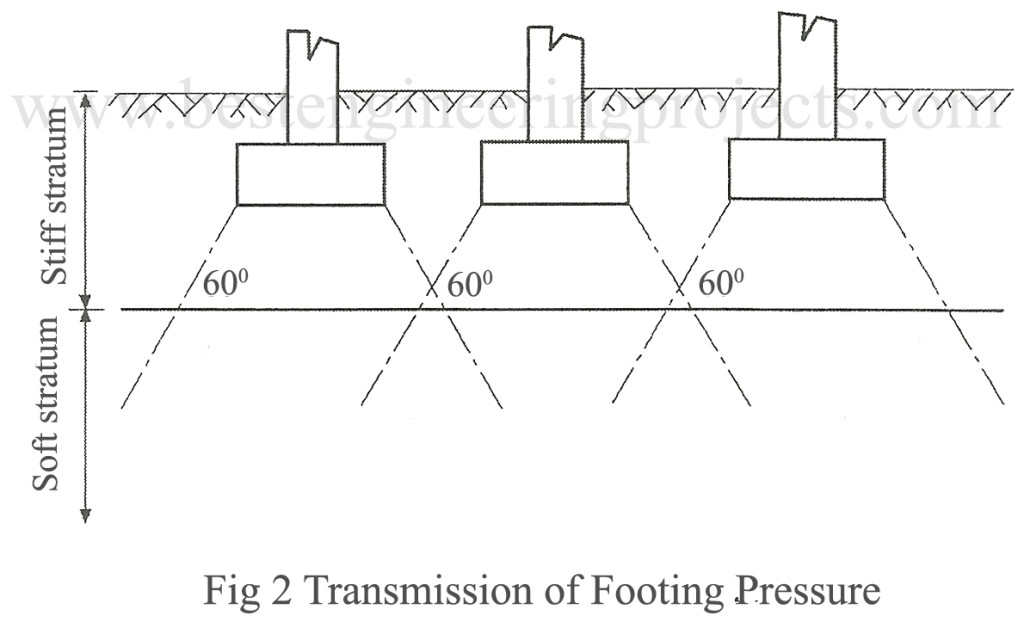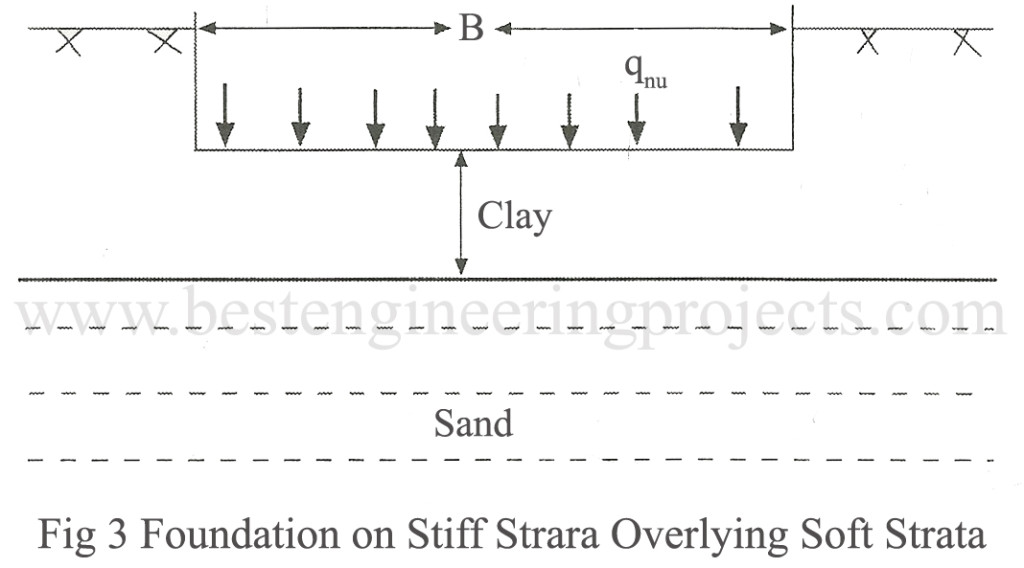Introduction of Footing settlement of Spread Foundation
The footings settlement on sands is determined from the results of plate load tests or penetration tests. The footing settlement computation from plate load tests has already been posted. The computation of footing settlement in sand from the results of penetration is not introduced in this level.
(a) Foundation in non-homogeneous strata
Soft Soil Overlying Firm Strata – If a foundation is to be laid on a soft strata overlying on a firm strata, the feasibility of the foundation is to be assessed. Safe bearing capacity is computed on the assumption that the soft strata extend to great depths. The footing settlement is also estimated. If bearing capacity is too small land footing settlement is too great the spread footing would have to be eliminated. The excess soil is excavated and a raft foundation should be provided. Alternatively pile or pier foundation would be required.
Dense or Stiff Layer Overlying Soft Deposit – If the foundation is close to the soft layer, it may break into layer by punching. Under such circumstances, the footing settlement due to consolidation may be excessive. In order to check the stability of the foundation, the bearing capacity of the stiff as well as soft layer is calculated. The pressure transmitted on the top of soft layer by the foundation load is determined by assuming a load dispersion of either 300 to the vertical or 2V: 1H as shown in Fig.1
The load distribution for a square or circular foundation is done approximately as per the equations given below or by using the stress distribution theory:
for 2V:1H distribution ———- (1)
for 300 distribution with vertical ———- (2)
Similarly the load distribution for a strip foundation is done approximately as per the equations given below or by using the stress distribution theory:
for 2V:1H distribution ———- (3)
for 300 distribution with vertical ———- (4)
Where, q1 = pressure transmitted on the top of the soft layer
qn = Net pressure imposed on the foundation
B = Width of the foundation
d = depth to soft strata from the base of the foundation
The distribution of stress is illustrated in Fig.2 below.
The value of q1 should not exceed the allowable bearing capacity of the sort strata Increasing the size of the foundation, if the footings are widely spaced i.e. spacing greater than or equal to four times the width of the foundation can reduce the value of q1. If footings are closely spaced, the transmitted pressures from adjoining footings get overlapped and the resulting pressure is doubled.
If q1 is greater than the allowable bearing capacity of the soft clay, combining all the footings to form a raft foundation can reduce the applied pressure. If the footings are in a row, combining all the footings in the row can reduce the pressure. In such case, the stiffer stratum acts as a natural raft beneath the foundation. If d is greater than half of the width of foundation, the resistance of stiff clay in forming a natural raft is allowed for by the following procedure
The pressure on the top of the soft stratum is given by:
Where, W is the total load on the foundation. A is the base area of the foundation and Ps is the perimeter shearing resistance, which is given by:
If still q1 is greater than applied pressure, deep foundations resting on a deeper bearing stratum are to be explored.
(b) Footing Constructed on a Thin Clay Stratum
When foundations are constructed on a thin surface stratum of clay overlying a relatively rigid stratum as shown in figure 3, there may be a tendency for the thin layer to be squeezed from beneath the foundation, particularly if the Soft layer is of varying thickness.
Net ultimate bearing capacity of the thin clay layer is by,
for
for strip foundation of width B ———- (5)
for
for circular foundation of diameter B ———- (6)
For smaller values of B/d than those given above, qnu can be obtained from for the relation of a thick clay layer.
It Should be noted that, with a thin clay layer, plastic deformation resulting from over stressing begins at a lower foundation pressure than with a thick clay layer. For both strip and circular foundations, the maximum shear Stress induced in the clay stratum is approximately taken as ½qn.


